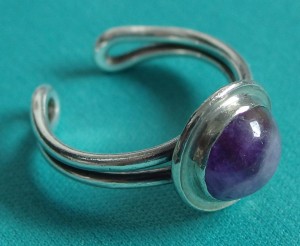The woman on the moor
 The ring is nothing fancy: a cabochon of amethyst quartz clumsily set in a plain silver bezel. No magic symbols engraved on the back. Yet it is a talisman. Whenever I wear it, I hear in my mind the unspoken message of the woman who sold it to me.
The ring is nothing fancy: a cabochon of amethyst quartz clumsily set in a plain silver bezel. No magic symbols engraved on the back. Yet it is a talisman. Whenever I wear it, I hear in my mind the unspoken message of the woman who sold it to me.
The year was 1966. Knowing it might be our last year in England, our family (husband, two infant boys and me) took a summer trip through England and into Scotland, staying mostly in private homes that offered bed and breakfast. A farm in the Peak District of Derbyshire. Across the Yorkshire Dales to Huddersfield and Keithley, from whence my paternal grandfather had emigrated as a young man to New Zealand. Up to a gray stone village on the moors to take tea with a sweet great-aunt who had married and stayed behind when her siblings left, and whose knowledge of the whole New Zealand branch of the family put me to shame. The Lake District, lowering with storm clouds and redolent with Wordsworthian cadences. A stone circle near Keswick. Hadrian’s Wall, a loch in Scotland. Yellowing pictures now fill a photograph album.
The little roadside shop was somewhere in the northern hills of England, on our way home. A gray, damp day, a gray, bleak building. Nothing much else around. We all needed a break from driving, so we stopped. Quickly bored with the arts & crafts contents of the shop, our toddler and the baby drifted outside with their father. I lingered, drawn to the young woman attendant, who sat at a table threading beads into a necklace. A knitted shawl around her shoulders, long mousy hair falling in a braid down her back. We chatted. She had left an unhappy relationship and was determined to survive on her own.
She had the confidence I lacked. Brought up in a conservative culture and married young, I was struggling with a sense of powerlessness in my traditional wife-and-mother role. There were times I felt trapped, and thought of escaping with the children back to New Zealand. But this would have felt like defeat. Besides, it was impractical. I had no money to pay for fare, no clue about how I would manage on my own once I got home.
My encounter with the woman on the moor was brief. I never learned her name. But the amethyst ring symbolizes an unspoken pact between us. What I gave her was good wishes and payment for her work. What she gave me was confidence that I too could find my inner strength. This is what I remember when I wear it.
I went through an identity crisis after my children were grown. For so many years I was mommy and his wife, I realized the “ME” was gone. It was then I went to college in my 50’s (a terrifying adventure) and became a registered nurse. My career gave me a sense of self worth, brought out my many talents and became one of my proudest achievements. I am so grateful I had the opportunity to grow and mature. My husband was supportive all the way.
I found your piece really moving. Those were the days when we hungered for more. And maybe couldn’t even talk to our friends about that.
I’m warmed up for this topic as I’m reading “The Lost Daughter’ by Elena Ferrante. A rather bleak book about a woman still struggling with the decision she made when her children were small, to leave them with their father – and that lengthened to three years. The difficulty of being ourselves and giving ourselves to our children simultaneously persists, I assume!
Glad the ring, or more likely your own resolve, moved you pass that rough spot in your youth.
the symbolic feelings that attach to rings–like moss on stone; they reach something deep in us, esp. when one acquires it by chance, as tho fate had left it there for you to find.
This is a lovely, evocative piece, Maureen. I can picture the shop and the young woman clearly and have been to Keswick myself. Wordsworthian cadences indeed.